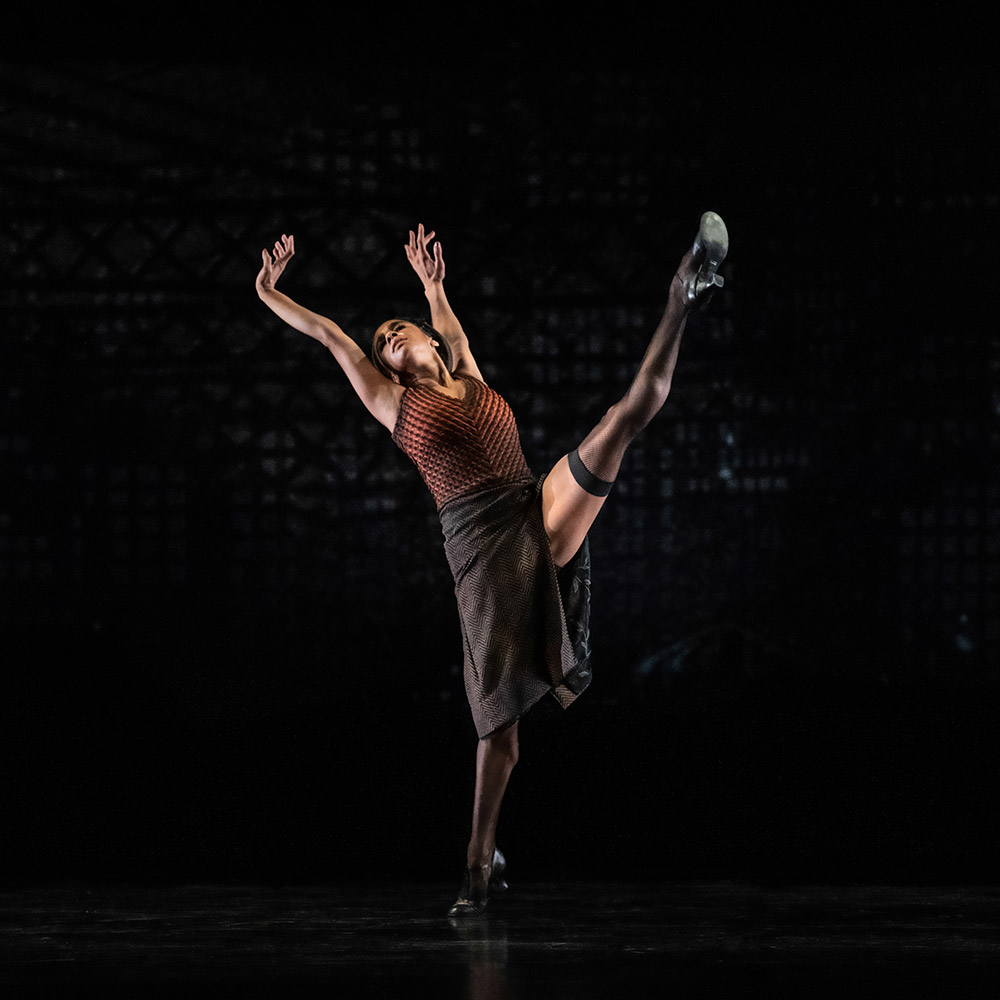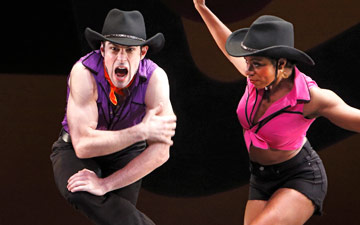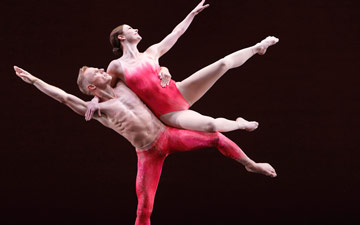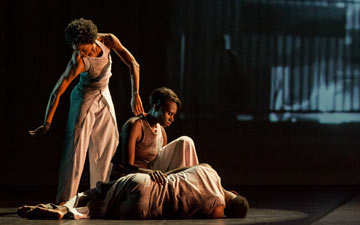
© Nina Wurtzel. (Click image for larger version)
Paul Taylor American Modern Dance
Gala: Concertiana, Only the Lonely, Episodes, Black Tuesday
★★★★✰
New York, David H. Koch Theater
30 October 2019
www.ptamd.org
davidhkochtheater.com
For as long as I can remember, Paul Taylor American Modern Dance (formerly The Paul Taylor Dance Company) has shown in its programs headshots of its dancers, in the order in which they joined the company. I’m sure I’m not alone in measuring my own life against the relentless march of a dancer’s face from the bottom row of this grid to the top, sometimes making it to that coveted upper-left corner for the company’s senior-most dancer. It seems like yesterday that, say, the long-retired Annamaria Mazzini was the new kid on the block; where have the years gone? How old was I when Michelle Fleet started marching up the grid? She’s in second place now, after Robert Kleinendorst. It can’t have been seventeen years, can it? Well, yes it can. Fleet is one of six veteran dancers who will have retired by the end of this this year; Fleet, Parisa Khobdeh, and Jamie Rae Walker this season; Michael Trusnovec and Laura Halzack are already gone, and Sean Mahoney will be by year’s end. This will also be Artistic Director Michael Novak’s last season as a dancer. The company will persevere and perhaps thrive; it will be considerably changed next year. I’m glad of the chance to bid farewell to Fleet, Khobdeh, and Halzack.
The evening began with Taylor’s last work, Concertiana, from 2018. Set to a rushing, lively score for orchestra and violin by Eric Ewazen, Concertiana often seemed a joyous, final statement of themes and ideas which have resonated throughout Taylor’s works for years. A long goodbye. At a few key moments a dancer will look straight at the audience, as if the dance is one long curtain call. Here’s that unmistakable, low, side to side hop from the “cavemen” part of Cloven Kingdom, there’s a line of dancers crossing upstage, backlit silhouettes like the morose, shadowy soldiers of Company B, although here they’re bounding happily. And throughout, Taylor deploys his ensemble in files of sometimes four, sometimes five dancers, rushing on and offstage as in Esplanade. Here, lines run, skip, crawl, a pair of them rushing through each other, or braiding and twining and dissolving with an intricacy and authority not much evident in Taylor’s later works; a last, welcome, return of the hand of the master.
In Concertiana, Taylor plays the individuality of his leads against the little communities of his ensembles, a favorite device of his, both compositionally and thematically; here, he’s in his Apollonian mode, and it’s a friendly counterpoint. Early on, Michael Novak appears upstage center, and fixes his gaze on the audience while walking straight towards us, his feet taking tiny, oddly constrained steps, almost as if they’re bound together. In his long solo, the tightness of his arms speaks of lifting, building, creating, raising the low (here’s where that Cloven Kingdom jump comes in) on high. He’s doing important, solemn work. (From now on, that important work will be as the company’s artistic director.) Later, Heather McGinley is one of Taylor’s lyrical high priestesses, invoking something beautiful that’s high above our heads, her arms always reaching and opening, as if spreading about some heavenly ectoplasm, or wrapping delicately around her torso as she travels and turns. She rushes offstage (too soon!), but returns, the arc of her trajectory leaving her on her back, facing upstage yet favoring us with a quick, upside-down glance. As with Novak’s long look, it’s both invitation and acknowledgement, and a bit of a farewell. In a later, third solo, Alex Clayton favors us with some leaps and spins and more bravura than I’m used to from Taylor. If Novak was building, and McGinley invoking, Clayton’s living, furiously and gleefully.
Near Concertiana’s end, Taylor brings all his dancers onstage, and dissolves their ensembles and formations into an assembly of individuals; everyone’s doing something different, yet complementary. The dancers coalesce into a tight little ziggurat, all smiling at us as if posing for a picture as the curtain falls.
Compared to Concertiana’s richness, Kyle Abraham’s Only the Lonely, a premiere, is a delicate sketch, a homage to one of Taylor’s favorite themes, not surprisingly given the title, loneliness. Set to recordings of familiar torch songs not entirely belted out by Shirley Horn, Only the Lonely recalls Taylor’s many studies of loneliness in a crowd. However, Abraham shows us, not individuals versus groups, but eight people in uncertain relationships which form and dissolve with sad regularity. Abraham’s vocabulary flirts with a familiar jazziness: the piece begins with a happy duet which favors Eran Bugge’s and Alex Clayton’s shaking their not-unimpressive booties, and it looks as if this is going to be another iteration of the vaguely sociable, jukebox dance we’ve seen countless times before.

© Nina Wurtzel. (Click image for larger version)
Having created this expectation, Abraham quickly subverts it, and I think Bugge’s and Clayton’s dance is the only time he allows a relationship to last through an entire song of Horn’s; modern love can be complicated. As Horn sings a paean to money in “Loads of Love,” the statuesque Lee Duveneck, made more so by his ensemble of heels, a blue sheath of a dress, and a towering, carrot-top wig, is both brave and vulnerable, swaying with a delicacy which belies his size. Catching the eyes of Robert Kleinendorst and Sean Mahoney, he joins them in a trio which hints it might jell into a threesome. But in striking a pose before his would-be beaux, Duveneck throws in too much chin, and he looks as shocked as we are when his wig tumbles off at the very last beat of Horn’s song. (My burlesque-dancer date informs me this is known in the trade as a wig reveal, and Duveneck’s impeccable, slapstick timing suggests he might have a fine career in other venues, should he ever tire of this modern-dance thing.)
Abraham has made two killer solos, one a bittersweet farewell number for the retiring Michelle Fleet, to “Ten Cents a Dance,” the other a welcome to Devon Louis, a powerful and charismatic relative newcomer, to “Only the Lonely.” In the sudden upstage murk of Dan Scully’s dramatic lighting, Fleet spends almost the entire song traversing the stage from our left to right. She’s nearly a silhouette against the backdrop’s impermanent dimness, but not so much of one to keep us from admiring the power and suppleness of her back, which always faces the audience, squirming and rippling as her hands delicately trace what might be fragments of half-remembered taxi-dances. Like the song, Fleet’s solo is drenched in wistful nostalgia, and also irony; her dances are beyond price. She does look like a million dollars in Karen Young’s dramatically backless red dress.
Scully set Fleet in cozy murk, but for “Only the Lonely,” he made a diagonal river of light, down which Louis navigates until he arrives at a downstage corner, where he’s suddenly lit up (along with half the audience, it seems) by a dazzling light from the heavens of the theater’s fourth or fifth ring. Louis doesn’t suffer from loneliness or triumph over it, so much as find in it a state of grace. He seems to grow more erect, his sinuous arms more expansive, as he approaches that downstage corner. Is Abraham allowing Fleet to retire into the shadows while literally thrusting Louis, a budding star, into the spotlight?
The wigless Duveneck returns to engage more physically with his pair of not-quite-suitors. Though Duveneck looms over them physically, and partners each with ease, he tempers his strength with an emotional frailty. It’s hard not to feel a twinge of sympathetic pain when he’s abandoned by Kleinendorst and Mahoney, who’ve paired off. When Fleet and Louis meet, their own pairing seems inevitable, and, in Abraham’s world, inevitably short-lived. For a few moments, all eight dancers play musical partners, with eerie embraces in which they don’t quite touch, hands hovering an inch over potential amours’ shoulders like air-kisses of affection. They drift apart, one random couple (I couldn’t tell you who) waltzing into the wings, the rest drifting more singly than in pairs into the shadows surrounding a final pool of light where Clayton’s standing alone, in a ballroom pose with one arm held wide for a partner who isn’t there, and may never be.
As a special one-off, Michael Trusnovec, now a guest artist, danced the solo from George Balanchine’s spiky and ascetic Episodes (to Anton von Webern’s Variations, Op. 30) which he made for Paul Taylor in 1959. I remember (vaguely) seeing the late Peter Frame dance this once at a New York City Ballet program, many years ago. Clad in dazzling white, Trusnovec made a glorious, Apollonian figure; was this how Taylor looked decades ago? The solo is so far removed from the original now (Trusnovec was taught it by Jovani Furlan, who learned it from Frame), it’s hard to assess its original impact, although it offers tantalizing glimpses of Balanchine testing Taylor’s supple prowess. Fittingly, to Webern’s spiky, amelodious score, the solo’s a collection of disjointed images. Trusnovec is good at blink-of-an-eye transitions; one instant he’s a rubbery ball folded in on himself, the next he’s reaching heroically to the heavens. There’s a fair amount of repetition here; I’m not sure whether Balanchine repeated long sequences, or scrambled his steps, but Trusnovec would sometimes half-pivot, one flexed footed leg kicking high like a Frankenstein’s monster, or stand like a rubber-filled scarecrow, hips akimbo, hands drooping from nerveless wrists. He’d furl and compress himself into the solo’s iconic image: in a deep squat, head bent, hands dangling below his head, twitching nervously as he’d wrap them and unwrap them about his ankles with mysterious urgency, looking for all the world like the proboscises of the “fly in a glass of milk” Balanchine is said to have told Taylor to emulate. You can practically see the bug-eyes growing from his shoulders. He often wrapped an arm around a lower leg like this, sometimes coming close to the hunched over pose in Phlegmatic from The Four Temperaments in which the dancer similarly hoists a foot. Indeed, Trusnovec’s creature often seemed a relative of both Phlegmatic and Melancholic (there’s that sad scarecrow), in a losing battle with gravity which ends with Trusnovec sprawled flat, arms reaching desperately towards the audience as he vanishes in shadow; I pitied the fly poured down the drain.

© Nina Wurtzel. (Click image for larger version)
The program closed with Taylor’s beloved and cynical depression-era Black Tuesday, with Misty Copeland as a guest artist. Copeland fitted in like she’d been dancing with the company for years, portraying one of Sean Mahoney’s three prostitutes in Are You Making Any Money?, then was piercing and heart wrenching in The Boulevard of Broken Dreams. I admired, and will miss, Jamie Rae Walker’s buoyant leaps and spunk in I Went Hunting and the Big Bad Wolf Was Dead. It has long been a peculiarity of this company’s casting that there’s one top dog who gets all, or most, of the glamor roles. Years ago this was Patrick Corbin, then Michael Trusnovec. Now that Robert Kleinendorst has arrived at that upper-left corner, these roles appear to be his, although, as in tonight’s Brother Can You Spare a Dime?, the necessary bravura seem no longer a part of his toolbox. He’s still a great dancer, and his charm and personality should be enough to carry him through however many seasons this long-deserved victory lap may last. It will be interesting to see if Novak keeps this top-dog approach to casting, or will he give more of his charges a chance while they can still do them properly?

















An absorbing and reflective review, Eric – I feel something of the pang as well, though
it will be February opr March when it arrives in San Francisco. So much to remember, so much to anticipate. Thanks for being so detailed.
This is an excellent review. I saw. 3 Paul Taylor performances last month, and I think you clearly capture the choreography and the performances by these wonderful dancers.
Keep up the good work.